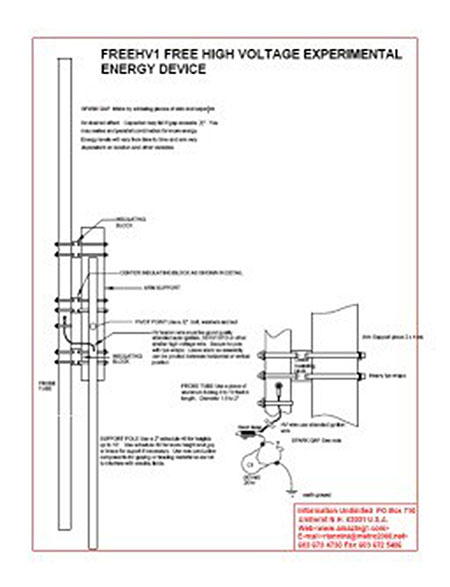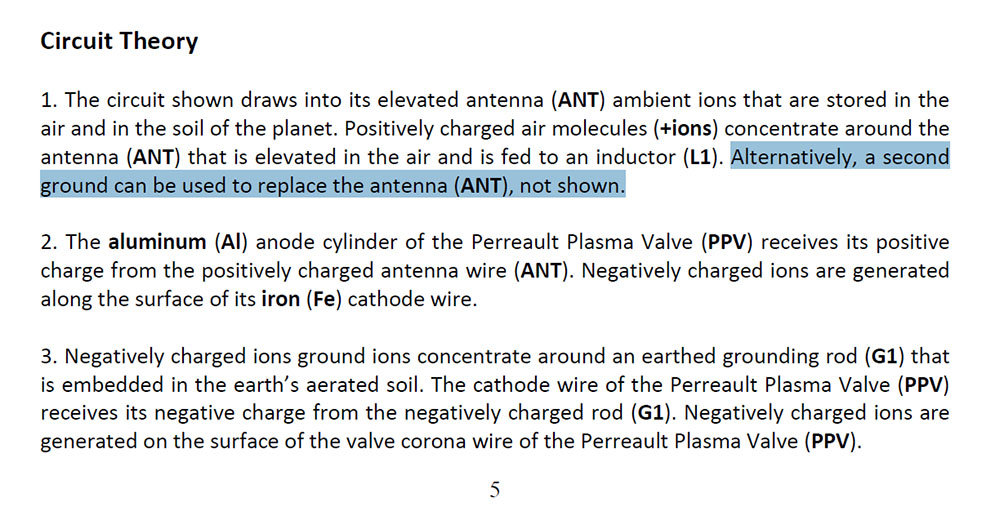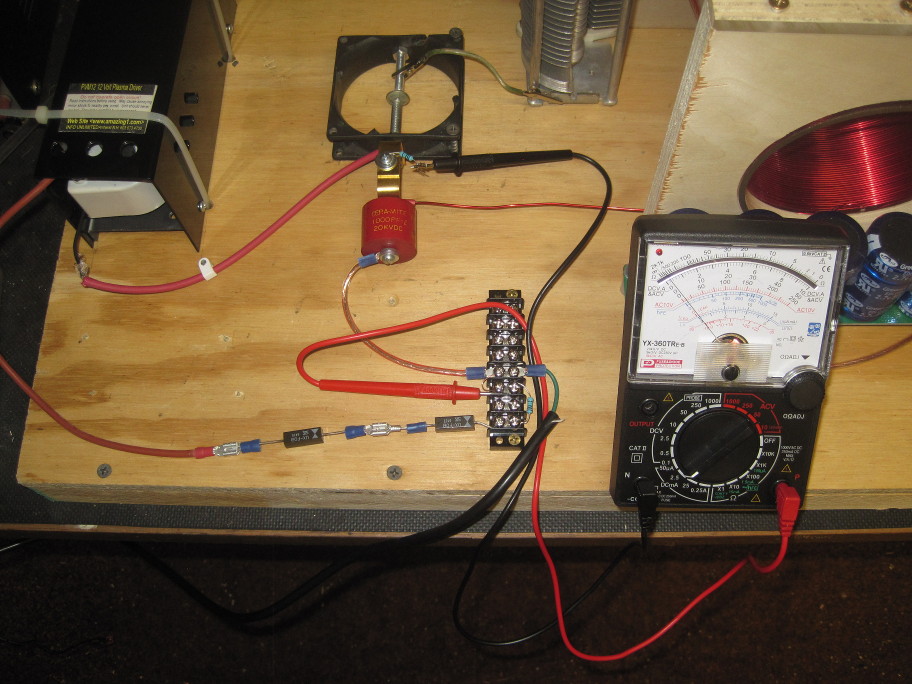Well, I found at least part of my problem. I finally bought an ANALOG voltmeter, I got tired of frying digital ones. Not that I'm careless with them, but operating close to spark gaps and high voltage oscillating circuits does funny things to them and eventually causes damage. I have a 100M HV rated resistor on order but not in yet, but I do have a few 10M film resistors that can take a couple kilovolts in my parts bin. So I hooked up a resistor and the multimeter to measure current through the resistor. To my surprise, C1 is only charging to around 1,000 volts. It should be much higher, 10KV at least. So somewhere I have a conductive path to ground that's leaking enough current to matter, or else my PVM12 is not operating properly. It does light up fluorescent tubes just fine so it's not obvious what the problem might be. So now I need to do more checking and see if there's a subtle leak somewhere. One of the problem with high voltage projects is that we are often using parts that aren't HV-rated, take the terminal blocks for example. Even with proper insulation on the wires, there can be conductive paths through wood or other materials. Exposed joints are a problem. Any sharp points or small radii can have corona loss. The higher the voltage the worse it gets.
Announcement
Collapse
No announcement yet.
Donald Smith Devices too good to be true
Collapse
X
-
Here is an antenna design that I purchased plans and tested years ago. Much simpler than stringing lots of wire in the air. At the time, I used a battery between ground and the cap connection to polarize the cap and was able to get 4-10 watts of energy periodically. It would run consistently in the range of 5 to 20 hz with varying degrees of output. Using a 2 in dia tube 8 ft long offers the same surface area as 500 ft of 20 ga wire.
With the HVM it might be enhanced to operate at higher frequencies... the trick might be in the balancing of power required to maintain the HVM and energy harvested by the system. As well, like Tswift is experiencing, controlling the "leaks"
Free High Voltage Energy From The Air (Downloadable Plans) - Information Unlimited
Just a thought from past experiences with HV harvesting...
Comment
-
Very interesting Dragon!Originally posted by dragon View PostHere is an antenna design that I purchased plans and tested years ago. Much simpler than stringing lots of wire in the air. At the time, I used a battery between ground and the cap connection to polarize the cap and was able to get 4-10 watts of energy periodically. It would run consistently in the range of 5 to 20 hz with varying degrees of output. Using a 2 in dia tube 8 ft long offers the same surface area as 500 ft of 20 ga wire.
With the HVM it might be enhanced to operate at higher frequencies... the trick might be in the balancing of power required to maintain the HVM and energy harvested by the system. As well, like Tswift is experiencing, controlling the "leaks"
Free High Voltage Energy From The Air (Downloadable Plans) - Information Unlimited
Just a thought from past experiences with HV harvesting...
Will research this.

Here is an extract of Bruce's latest PDF

This might be more favourable!
Comment
-
No current flow in this part so take your pick!Originally posted by Wistiti View Posthi guys!
do the 500k pot have to be a powerfull one or a small one is ok? What is the sugest watt for it?
Thank you!
500k potentiometer | eBay
Seems dearest one is 9 bucks!
Comment
-
Well, at least part of my problem appears to be in the diodes. Those UX-FOB diodes I've been using are rated 8KV but they don't seem to be working right. I substituted the two diodes shown in the picture for a single HVM-12 standard recovery (non-ultrafast) microwave oven type diode and actually got around 3KV on the capacitor instead of 1KV. The "standard recovery" diodes don't actually say how fast or slow the reverse recovery time spec is, it could be fast enough to be useful but I have noticed before when using them that although they do give some rectification at 30+ KHz frequencies, they also get warm and I'm sure there is some reverse leakage during the recovery period every cycle.
So I'm stuck on progress until my diodes come in, I have some 30KV 100ns 100 mA diodes on order but coming from China (groan). Might be a week or more before I see them. I did receive my large spool of 40KV wire so I can begin building the coils for the next upgraded version in the meantime, doing calculations now.
Comment
-
Yes, it has Dragon.Originally posted by dragon View PostI noticed the mention of 2 grounds - has it been built and tested?
You know more than most people about using two hot spot earths and that it works.
You're probably one of the very few that knows already how to set up the earths too.
A counterpoise antenna will work too but which is a better option.
What we can't do is compare results from both antenna/ground, ground/ground in multiple locations around the world.
So here it is for replicators to try, if they wish to.
Mwtj, you could do a comparison test and see what works better and provide third party validation.
In theory it should work in low elevations.
That hasn't been tested.
Mwtj is in Holland and hasn't exactly got a high elevation, yet he got the circuit working with no insulators and lots of leakage.Last edited by soundiceuk; 01-02-2017, 11:51 PM.
Comment
-
Yes 100ma, 30KV, 100NS are perfect for D5.Originally posted by tswift View PostWell, at least part of my problem appears to be in the diodes. Those UX-FOB diodes I've been using are rated 8KV but they don't seem to be working right. I substituted the two diodes shown in the picture for a single HVM-12 standard recovery (non-ultrafast) microwave oven type diode and actually got around 3KV on the capacitor instead of 1KV. The "standard recovery" diodes don't actually say how fast or slow the reverse recovery time spec is, it could be fast enough to be useful but I have noticed before when using them that although they do give some rectification at 30+ KHz frequencies, they also get warm and I'm sure there is some reverse leakage during the recovery period every cycle.
So I'm stuck on progress until my diodes come in, I have some 30KV 100ns 100 mA diodes on order but coming from China (groan). Might be a week or more before I see them. I did receive my large spool of 40KV wire so I can begin building the coils for the next upgraded version in the meantime, doing calculations now.
Comment
-
I haven't been having luck with ux-fob diodes working well either, or cl01-12, if you want something to try in the meantime while your china ones come in try 1n5408 https://www.amazon.com/gp/product/B0...?ie=UTF8&psc=1
connected in series in a chain. cheap enough to see if they do what you need. I don't know the specs aside from what you see on the amazon ad.
Comment
-
Yeah, if I had a bunch of 1N5408 diodes laying around it would be worth a try. Regular HV diodes internally are just a bunch of diodes in series, which is why they have a larger forward voltage drop than regular diodes. So it would probably end up acting a lot like the HVM-12 diodes I already have. I notice that the datasheet for the 1N5408 device only specifies characteristics at 60 Hz and doesn't specify reverse recovery time so it's certainly not an "ultrafast" or probably even a "fast" design or they would make a point of it. Doesn't mean it won't work but probably won't work well. Unfortunately there's really no substitute for true HV diodes that are also high speed. By the time you add "high voltage", "high speed" and "high current" into the mix, you get devices that are neither small nor cheap, I paid almost $4.00 each for the 100 mA 30KV 100ns diodes.
http://www.diodes.com/_files/datasheets/ds28007.pdf
Comment
-
I should have mentioned, I'm glad to know it's not just me having problems with the UX-FOB devices. They seemed like a good buy for the specs, an 8KV 500 mA diode for not insane money but they don't seem to work well in practice. I didn't know whether mine had just suffered from the various experiments I have put them through or whether it's the diodes themselves. I found a datasheet for them and they look OK on paper, 8KV, 0.5A, 40 ns. I have done some experiments where I got better results with the HVM-12 non-fast diodes even at 30 KHz or higher, so that made me suspicious. I would recommend other experimenters steer clear of them.
Comment
-
Ultrafast Diode
Originally posted by tswift View PostYeah, if I had a bunch of 1N5408 diodes laying around it would be worth a try. Regular HV diodes internally are just a bunch of diodes in series, which is why they have a larger forward voltage drop than regular diodes. So it would probably end up acting a lot like the HVM-12 diodes I already have. I notice that the datasheet for the 1N5408 device only specifies characteristics at 60 Hz and doesn't specify reverse recovery time so it's certainly not an "ultrafast" or probably even a "fast" design or they would make a point of it. Doesn't mean it won't work but probably won't work well. Unfortunately there's really no substitute for true HV diodes that are also high speed. By the time you add "high voltage", "high speed" and "high current" into the mix, you get devices that are neither small nor cheap, I paid almost $4.00 each for the 100 mA 30KV 100ns diodes.
http://www.diodes.com/_files/datasheets/ds28007.pdf
you could try the Ultrafast version of 1N5408, just replace "1N" with "UF". UF5408
http://www.vishay.com/docs/88756/uf5400.pdf
75 ns recovery time
I ordered a lot of these cut them short, connect by soldering and wrap them with teflon then electrical tape, put it inside a ballpen *case for extra protection and sturdiness and you will have UF high voltage diode with less leakage (its just going to be longer than the expensive ones.), but it works, this is what I use.
or maybe the low amp version of it. uf4007 (1kv 1A). these are more flexible and much easier to connect to form like a spiral, so it wont be that long (considering you have to connect 30 in series to achieve 30kv).
Comment

Comment